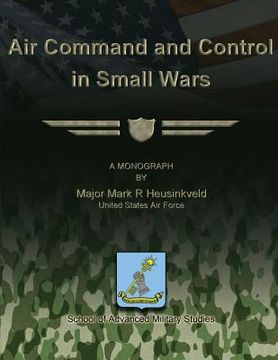Share
Air Command and Control in Small Wars
Us Air Force Major Mark R. Heusinkveld
(Author)
·
School Of Advanced Military Studies
(Contributions by)
·
Createspace Independent Publishing Platform
· Paperback
Air Command and Control in Small Wars - Studies, School Of Advanced Military ; Heusinkveld, Us Air Force Major Mark R.
Choose the list to add your product or create one New List
✓ Product added successfully to the Wishlist.
Go to My Wishlists
Origin: U.S.A.
(Import costs included in the price)
It will be shipped from our warehouse between
Friday, July 26 and
Friday, August 02.
You will receive it anywhere in United Kingdom between 1 and 3 business days after shipment.
Synopsis "Air Command and Control in Small Wars"
There has been much discussion about the best use of airpower in small wars, specifically with regard to current operations in Afghanistan. Coalition air forces involved in Operation Enduring Freedom use the same command and control (C2) structures doctrinally established for all types of operations. The Air Force doctrine of centralized control and decentralized execution drives the makeup of C2 within the operation. Is there a better way to structure airpower in small wars? Although neither France nor the United States met their strategic objective, air operations by the French in Algeria and the United States in Vietnam provide contrasting models of C2 structures for a comparative case study. The French saw the importance of a decentralized model to maximize the support of ground troops. To use modern terminology, the French set up a joint task force in each geographic section of Algeria. Each geographic area had its own air command post collocated with the French Army command post within the region. The United States, on the other hand, centralized control of aircraft. United States Air Force (USAF) doctrine, in Vietnam, required that air assets be under the centralized control of a single air commander. Interservice rivalry heated this debate; the USAF was unwilling to allow anyone other than an air commander to control aircraft. The USAF argued that decentralization of airpower could easily have wasted the scarce air resources found in theater. However, it was centralized in name only. Aircraft were commanded and controlled under a variety of organizations to include, 7th Air Force, 13th Air Force, the Central Intelligence Agency, and the US Embassy. Both operations provide insight into the effectiveness and efficiency of the air C2 structures. This monograph asks if the structures used by the air forces in these conflicts can provide lessons for the United States in small wars today. If current structures are not as effective or efficient, commanders can modify the structures, using the insights gained by this monograph, to provide better support to ground operations in today's small wars.
- 0% (0)
- 0% (0)
- 0% (0)
- 0% (0)
- 0% (0)
All books in our catalog are Original.
The book is written in English.
The binding of this edition is Paperback.
✓ Producto agregado correctamente al carro, Ir a Pagar.

